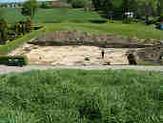Find of a Kufic coin
Early in May 2009 archaeological excavations were begun at Thyras Have, immediately east of the North Mound at Jelling. In connection with these, Peter Hyldgaard from Jelling found a small, well-preserved Arabic coin. It is a so-called “Kufic” coin, a type which dates to the period c.700- c.970 AD.
Contact between Denmark and the Muslim world does not just date to recent times. As early as the Viking Age there were vibrant trading connections between Scandinavia, via the Russian rivers, and the present-day Irak, Central Asia and the Middle East. The coin is tangible evidence of this.
The Vikings did not have an actual coin economy. Instead the coins were used as a medium of payment based upon their weight, as was the case with other silver objects. Therefore, Kufic coins are often found cut into smaller pieces. However, the newly found coin is complete and a small suspension hole has been made in it. This indicates that, beyond use as a medium of payment, it has functioned as a piece of jewellery or perhaps an amulet.
It is the second time that an Arabic coin has been found in Jelling. A few years ago half a coin appeared in the field north of Thyras Have and west of the farm known as Nørrelide. At the National Museum’s Collection of Coins and Medals it was decided that it originated from the modern-day Morocco and was struck in the period 792-808 AD.



